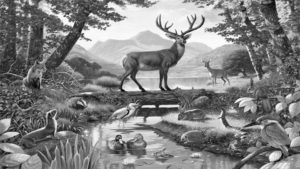Kālidāsa has probably provided us with the finest pictures of the pure life led by sages in hermitages. It is among the many things that he has pioneered. From his description of life in hermitages, it is clear that a sage is one who is more humane than most humans. It is because of this that he becomes divine in the larger sense. It is not as if he has no concerns; it is just that he is concerned about everything around him. And it is not as if he has given up everything; it is just that he accommodates everything. And finally, it is not as if he has given up pleasures; it is just that he is pleased with himself. It is this lofty ideal that Kālidāsa has presented in his works. We shall have the privilege of looking at a few of them.
We shall start with the hermitage of Sage Vasiṣṭha on an evening as seen by King Dilīpa in Raghuvaṃśam.
आकीर्णम् ऋषिपत्नीनाम्
उटजद्वाररोधिभिः |
अपत्यैरिव नीवार-
भागधेयोचितैर्मृगैः ||
When the wives of the sages were taking the sun-dried grains back into their huts, they were stopped at the door by deer demanding their daily share of grain. They appeared like the children of those women for the liberty and love they enjoyed.
सेकान्ते मुनिकन्याभिस्-
तत्क्षणोज्झितवृक्षकम् |
विश्वासाय विहंगानाम्
आलवालाम्बुपायिनाम् ||
The young girls of the hermitage would fill the trench around the root of the trees with water and quickly walk away from there. This was to allow the birds to quench their thirst without any fear from anyone being present around them.
आतपातयसङ्क्शिप्त-
नीवारासु निषादिभिः |
मृगैर्वर्तितरोमन्थम्
उटजाङ्गनभूमिषु ||
The grains which had dried during the day were piled up during the evening in the grounds of the hermitage. That served as a cushion for the deer who would sit and ruminate on those piles.
And then, we can look at king Raghu enquiring about the well-being of the hermitage of Sage Varatantu, when talking to his pupil Kautsa.
आधारबन्धप्रमुखैः प्रयत्नैः
संवर्धितानां सुतनिर्विशेषम् |
कच्चिन्न वाय्वादिरुपप्लवो वः
श्रमच्छिदं आश्रमपादपानाम् ||
I hope the trees of your hermitage are not being troubled by wild winds or any other troubles. They have been brought up like their own sons by the people of your hermitage and have been relieving everyone of their tiredness.
क्रियानिमित्तेष्व् अपि वत्सलत्वाद्-
अभग्नकामा मुनिभिः कुशेषु |
तदङ्कशय्याच्युतनाभिनाला
कच्चिन्मृगीणामनघा प्रसूतिः ||
I hope the fawns of your hermitage are fine. They enjoy the comfort of the laps of your sages’ till the remains of their umbilical cords drop off and they also enjoy the luxury of feasting on the blades of grass collected by the sages for their rituals.
निर्वर्त्यते यैर्नियमाभिषेको
येभ्यो निवापाञ्जलयः पितःणाम् |
तान्युञ्छषष्ठाङ्कितसैकतानि
शिवानि वस्तीर्थजलानि कच्चित् ||
I hope the water-bodies in your hermitage which are used by the people of the hermitage for their ritual bath and oblations are hale and healthy. Their banks are littered with the grain offerings made by the hermits who believe in handing over a sixth of their share to the king.
And then, we can look at the advice given by sage Vālmīki to Sītā, who is picked up by sage Vālmīki in a pregnant condition after she has been sent to the forest by Rāma.
पयोघटैराश्रमबालवृक्षान्
संवर्धयन्ती स्वबलानुरूपैः |
असंशयं प्राक्तनयोपपत्तेः
स्तनन्धयप्रीतिमवाप्स्यसि त्वम् ||
In our hermitage, you shall water young saplings from water-pots suited to your carrying. That way, you shall feel the joy of breastfeeding your kids even before you have given birth to them.
In Kumārasambhavam, Lord Śiva, in the guise of a brahmacāri enquires Pārvatī about the well-being of her hermitage.
अपि प्रसन्नं हरिणेषु ते मनः करस्थदर्भप्रणयापहारिषु |
I hope you are happy about the liberty the deer take in snatching the blades of grass from your hand.
Here, the poet seems to imply that such wide-ranging compassion is the expected result of penance. And who better to talk about it than the primordial hermit, Lord Śiva? After all, he has accommodated everything from the deadly poison hālahala to the divine river Gaṅga, and has no problems with snakes inhabiting his body.
Finally, we can see one last glowing example of life in hermitages from the ‘play perfect’ – Abhijñāna-śākuntalam. When Śakuntalā is preparing to leave the hermitage to go to her husband’s home, this is what she requests of her foster-father Sage Kaṇva –
तात! एषोटजपर्यन्तचारिणी गर्भमन्थरा मृगवधूर्यदानघप्रसवा भवति तदा मह्यं कमपि प्रियनिवेदयितृकं विसर्जयिष्यथ |
Father! Whenever the pregnant she-deer roaming around our hut here has a safe delivery of its baby, then please send someone to deliver me that good news.
And then, she is waylaid by a deer, which is described by Sage Kaṇva –
यस्य त्वया व्रण-विरोपणमिङ्गुदीनां
तैलं न्यषिच्यत मुखे कुशसूचिविद्धे |
श्यामाक-मुष्टि-परिवर्धितको जहाति
सोऽयं न पुत्रकृतकः पदवीं मृगस्ते ||
Look at this deer blocking your way! It has been like a son to you. When it injured its mouth while eating the sharp blades of grass, you had treated it with Ingudi oil. And it has grown up by eating grains out of your own hands.
With this, we shall take leave of the wonderful world of hermitages created by our master poet. In the next article, we shall see the message of Kālidāsa.

















































Comments